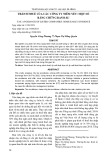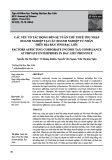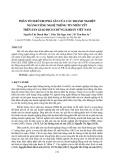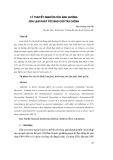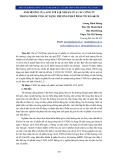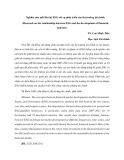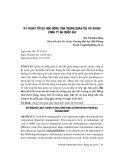
Journal of Science and Technology, Vol.37, 2019
© 2019 Industrial University of Ho Chi Minh City
FINANCIAL LIBERALIZATION AND COLLATERAL REQUIREMENTS
OF SMALL AND MEDIUM ENTERPRISES – EVIDENCE FROM SOUTH-
EAST ASIAN LOWER AND MIDDLE INCOME COUNTRIES
NGUYEN NGOC THUY VY, NGUYEN THI PHUONG DUNG, NGUYEN KIM QUOC TRUNG
Foreign Trade University – Ho Chi Minh City Campus
nguyenngocthuyvy.cs2@ftu.edu.vn, nguyenthiphuongdung.cs2@ftu.edu.vn,
nguyenkimquoctrung.cs2@ftu.edu.vn
Abstract
Small and medium enterprise (SME) sector is the main motivation for economic growth in developing
countries. However, SMEs encounter different challenges in their activities. One of the biggest obstacles
facing SMEs is the constraint on their accessibility to external finance due to the lack of collateral.
Financial liberalization, through their impact on credit market structure, may affect SMEs’ dependence on
collateral in accessing external finance. The main purpose of this research is to examine the influence of
financial liberalization on collateral requirements of SMEs in South-East Asian lower and middle income
countries including Vietnam, Indonesia and Philippines. To be specific, the author uses Probit and Tobit
regression with Enterprise Surveys Data of World Bank in 2009 and 2015 to evaluate the effect of
financial liberalization on the incidence of collateral loans and the level of collateral requirements. In
addition to financial liberalization - our main explanatory variable, we control other factors which may
affect SMEs’ collateral requirements such as country and firm characteristics. The main result shows that
financial liberalization increases the likelihood of collateral requirements.
Keywords.collateral, financial liberalization, lower and middle income countries, SMEs.
1. INTRODUCTION
In the early 1990s, developing countries began to carry out financial liberalization. The role of
financial liberalization in economic growth is the area that has received much attention from the research
community. The key point in this study is that financial liberalization is fully conducive to economic
growth [2]. [54] and [61], who were pioneers in conducting research which favored financial
liberalization, argued that financial liberalization increased the effectiveness of investment (both
qualitatively and quantitatively) and boosted the economic growth. However, recent financial crises have
made us reconsider the role of financial liberalization [2]. In a report on financial liberalization in 2012,
the International Monetary Fund, which previously maintained a consistent point of view that financial
liberalization brought benefits, and acknowledged that financial liberalization implies risks. The level of
risks increases due to the discord in financial markets. Financial liberalization accompanied by financial
constraints has a negative impact on economic growth [3]. [61] argued that financial liberalization does
not help solve information asymmetry problems, thus it did not increase the efficiency of financial
intermediaries. Other studies, such as [15], also argued that financial liberalization even exacerbates the
information asymmetry because it negatively affects credit relations between businesses and banks.
Collateral acts as an indicator for the quality of the business. Mortgages help: (i) mitigate the adverse
selection of lenders ( [15]; [16]; [24]); (ii) reduce representation cost between lenders and borrowers; (iii)
overcome the issue of under-investment [54]; and (iv) control risk transfer behaviors after signing a loan
agreement and thereby addressing ethical risks [16]. Hence, collateral plays the role of protecting the
lenders and encouraging them to provide credit to the business. The relationship between financial
liberalization and collateral requirements is still vague. Theoretically, financial liberalization may limit
the requirements for collateral due to the fact that financial liberalization has a positive impact on the
supply of capital (e.g. increasing capital and reducing cost of capital). Financial liberalization, on the
other hand, can also make collateral requirements more stringent. The reason is that financial

FINANCIAL LIBERALIZATION AND COLLATERAL REQUIREMENTS OF SMALL AND MEDIUM 25
ENTERPRISES – EVIDENCE FROM SOUTH-EAST ASIAN LOWER AND
MIDDLE INCOME COUNTRIES
© 2019 Industrial University of Ho Chi Minh City
liberalization increases information asymmetry, while reducing the quality of credit relationships between
enterprises and financial providers. In terms of empirical evidence, studies investigating the impact of
financial liberalization on collateral requirements are still rare. [39] is one of the recent studies exploring
the impacts of financial liberalization on collateral requirements. However, this study examines the
interaction effects of financial liberalization in the relationship between investment and collateral rather
than directly examining the impacts of financial liberalization on collateral requirements.
Small and Medium Enterprises (SMEs) are the driving force behind economic growth, especially in
developing countries. However, in the process of operation, SMEs face many obstacles. Data from the
World Bank's Enterprise Surveys showed that the greatest difficulty in the operation of SMEs is the
access to funds [33]. In many cases, financial institutions do not like to provide finance for SMEs because
the transaction costs involving in the verification of their credit documents due to their high risk nature.
Therefore, collateral is an essential condition for SMEs to access external funding. The role of collateral
is particularly important in underdeveloped countries where financial markets are poorly developed with
high levels of information asymmetry and poor enforcement [42]. By using the Word Business
Environment Survey data, [7] examined the severity of the 12 hurdles about corporate sponsorship that
companies encounter. The results show that mortgage requirements are ranked third among the biggest
funding hurdles. Surveys conducted in the European Bank for Reconstruction and Development's World
Bank and Enterprise Performance Survey and the World Bank for East and Central Asian countries also
show that the high demands for collateral is one of the most important reasons why businesses do not
have access to external funding.
This study was conducted to examine the impacts of financial liberalization on collateral
requirements (on the ability to use collateral in the loan agreement as well as collateral size) in SMEs.
The inspiration for the study came from previous research examining factors affecting collateral
requirements such as [9], [12], [13], and [52]. However, these studies focus only on SMEs in developed
countries while in developing countries with high level of information asymmetry, financial institutions
are unlikely to effectively control the risks of businesses, especially SMEs. Information about SMEs is
often lacking and less reliable due to few audited financial reports. In addition, weak credit information
systems, which are often ignored by small businesses, make it difficult to collect historical data. In
addition, the damage caused by bankruptcy in developing countries is often high due to incomplete
bankruptcy laws, complex legal procedures and limited financial institutions' ability to recover assets.
With these factors, we expect factors effecting the collateral requirements of SMEs in developing
countries will be different.
Recently, [33] investigated factors impacting collateral requirements. However, the two studies
focused only on East and Central Asian countries and did not take into account the role of financial
liberalization. In this study, we analyzed the role of financial liberalization in mortgage requirements. On
the sample, we investigated low-income developing countries in Southeast Asia including Vietnam,
Indonesia and the Philippines. Some of the reasons for choosing the sample include: (i) Southeast Asia is
one of the fastest growing regions in the world; (ii) strong financial liberalization in these countries; and
(iii) the lack of serious and comprehensive studies on the impact of financial liberalization on collateral
requirements.
In order to achieve the objectives of the study, we first built the model of the factors that impact
collateral requirements, including financial liberalization, business characteristics and characteristics of a
nation. Next, we used the Probit regression model to test the impact of financial liberalization on the
presence of collateral requirements in the loan agreement. To ensure consistency, test results from the
probit model will be compared to the results from the Logit model. We then examine the impact of
financial liberalization on the mortgage asset size through the Tobit model. In addition to using the
financial liberalization index to represent the degree of financial liberalization, we also use capital
controls to ensure the sustainability of the results. The paper shows that financial liberalization increases
the likelihood of a collateral requirement in a loan agreement. This consequence mainly lies in the fact
that financial liberalization influences information asymmetry, and thus stress the need to include the
requirement for a collateral. Hence, in the three sample countries, financial liberalization does not lower
the difficulty in accessing funds for corporate but it has the opposite pattern. Besides, although the

26 FINANCIAL LIBERALIZATION AND COLLATERAL REQUIREMENTS OF SMALL AND MEDIUM
ENTERPRISES – EVIDENCE FROM SOUTH-EAST ASIAN LOWER AND
MIDDLE INCOME COUNTRIES
© 2019 Industrial University of Ho Chi Minh City
regression coefficient of financial liberalization has a positive sign, implying that financial liberalization
increases the required collateral size, the impact of financial liberalization on the scale of collateral is not
statistical significant.
2. LITERATURE REVIEW
2.1. Financial liberalization
In the early 1990s, developing countries began to carry out financial liberalization. Financial
liberalization refers to government policy to repeal interest rate controls as well as credit control, remove
entry barriers for foreign financial institutions, privatize financial institutions, and abolish domestic and
foreign financial control measures. In the current theoretical framework, researchers continue to debate
the impacts of financial liberalization on the economy. Most of the views advocating financial
liberalization are based on Neoclassicalism, which assumes the market is capable of allocating resources
efficiently. Debate on financial market liberalization stems from research of [52] and [61]. [52] and [61]
criticized government policy control in the contemporary period, such as the setting of a cap on interest
rates and credit designation. According to the authors, financial control leads to inefficient and poor
allocation of funds, while liberalization of the credit and financial markets is likely to improve the
efficiency of capital allocation and stimulate economic growth.
The positive correlation between financial liberalization and economic growth is explained by the
following arguments. Firstly, financial liberalization is considered to be able to reinforce market rules and
competitiveness in the banking market, thereby raising the savings interest rate which leads to an increase
in percentage of savings. Increased savings mean a raise in resources for investment. Second, competition
is likely to put pressure on banks' special rate of return on lending rates. With low interest rates,
borrowing costs decrease, resulting in an increase in investment and output. Third, financial liberalization
extends risk diversification to financial institutions such as banks and investors in the capital markets.
Diversifying risk causes lower interest rates and reduces capital costs, thereby reducing funding limits,
enabling businesses to invest and help the economy grow. Fourth, if the banking sector is liberalized,
banks are motivated to improve operational efficiency by cutting fixed costs, improving management and
providing new financial services for the market. In addition, if financial liberalization involves the
opening of the domestic banking sector to foreign banks, the domestic banking sector can gain benefits
from new banking techniques and risk management as well as new financial instruments and services
coming from foreign banks. In general, the arguments suggest that financial liberalization improves the
efficiency of financial intermediaries, thereby increasing investment returns and accelerating economic
growth.
Contrary to the argument for financial liberalization, some studies suggested that financial
liberalization is likely to have a negative impact on the economy through realistic observation of financial
liberalization. Expected results lead to financial crises and economic depressions (such as the 2007-2008
economic depression, the financial crisis in Latin America in the 1980s and East Asia in 1997-1998).
First, [60] and other researches showed; therefore, it cannot improve the efficiency of financial
intermediaries. [62] demonstrated the problem of information asymmetry in financial markets. To put it
in other words, financial constraints still exist without government interference. Second, some studies
argued that financial liberalization even exacerbated information asymmetry. When the financial market
is free with a high level of competition, businesses have more options for low rate credit, and bank
borrowing is not favourable anymore. The decline in relationship-based lending negatively affects the
quality of the relationship between the business and the bank or, in other words, worsens the bank's
information base, thereby increasing information asymmetry in the banking system [20]. Third, increasing
competition in the financial markets implies a decline in performance and an increase in the level of
sensitivity of financial intermediaries. Reference [20] argued that financial liberalization reduced the
commercial value of banks. This decline caused banks to interrupt operations and stimulate them to take
risks in order to increase profit under the pressure of reducing the difference between deposit and lending
rates. Reduced profit margins due to low lending rates provide incentives for banks to lower the cost of

FINANCIAL LIBERALIZATION AND COLLATERAL REQUIREMENTS OF SMALL AND MEDIUM 27
ENTERPRISES – EVIDENCE FROM SOUTH-EAST ASIAN LOWER AND
MIDDLE INCOME COUNTRIES
© 2019 Industrial University of Ho Chi Minh City
approving and managing loans or choosing risky strategies in allocating loans (for example, banks are
more concerned about profits than the accompanying risk, so financial liberalization can trigger a crisis if
financial liberalization drives banks to take excessive risks under competitive pressure) ( [32]). Finally,
the increase in risk appetite in the financial markets together with higher risk of bankruptcy of banks and
financial intermediaries may lead to bank-run ( [30]). Bank-run is one of the main factors affecting the
stability of financial system.
The above discussion shows that, at least in theory, the nature of the relationship between financial
liberalization and economic growth is unclear. With the theoretical ambiguity, the relationship between
financial liberalization and economic growth needs to be verified by empirical evidence. However,
contrary experimental evidence does not clarify the relationship. Reference [30] showed that most studies
did not find convincing evidence of the relationship between financial liberalization and growth. The
author criticizes empirical studies without the appropriate testing methods to evaluate the effects of
financial liberalization. Reference [30] argued that analyzing the impact of financial liberalization from a
business perspective can shed light on the impact of financial liberalization on the real economy rather
than on the national level. When considering the impact of financial liberalization through the view of
enterprise, [49] conducted a research based on the data collected from 13 developing countries during
1988-1998 and concluded that financial liberalization reduced the funding limits in businesses, especially
small businesses.
2.2. Collateral
Collateral is a basic contractual agreement that minimizes costs arising from adverse selection and
problem of representation by allowing the bank to filter out risky businesses (16]) and by encouraging the
selection of low risk projects ( [62]) as well as timely repayment of loans ( [19] and [43]). However, the
theoretical framework suggests that collateral requirements may negatively affect the allocation of
resources within the enterprise. For example, if your investment depends on the value of your collateral,
your investment is usually below the optimal level; or the enterprise may hold assets that may be used as
collateral such as land and other fixed assets at a level higher than the optimal level from the technical
perspective ( [40]).
Previous studies have shown that information asymmetry in the assessment of investment projects
between banks and firms may lead to lower loan value than expected ( [62]). Recent studies state that
collateral can solve a particular kind of the information asymmetry problems mentioned above. The role
of collateral in a loan contract reflects the motivation and signals effects of addressing the problem of
adverse selection and moral hazard due to information asymmetry. If a loan is secured by a collateral, the
business is less likely to choose a risky project. In addition, asset mortgages can force businesses to
disclose potential risks. However, the use of collateral can be expensive for banks and businesses. Banks
charge for the valuation and management of collateral as well as liquidation of collateral when the
business loses liquidity. Businesses bearing high costs are required to prepare additional reports as
required by the bank as well as costs due to restrictions on mortgage use rights ( [52]). The more special
and illiquidity the collateral is, the more the cost related to collateral increases.
3. METHODOLOGY
3.1. Research model
We examine the impact of financial liberalization on collateral requirements by building a model in
which the collateral requirement is a dependent variable and financial liberalization is the main
explanatory variable. Mortgage requirements will in turn be measured in two respects: (i) the presence of
the collateral requirement in the loan agreement and (ii) the size of the collateral against the loan. In
addition to the main explanatory variable, we control for: (i) the characteristics of the enterprise and (ii)
the characteristics of the country. Our research model is based on the model of factors that influence
collateral requirements under [33].

28 FINANCIAL LIBERALIZATION AND COLLATERAL REQUIREMENTS OF SMALL AND MEDIUM
ENTERPRISES – EVIDENCE FROM SOUTH-EAST ASIAN LOWER AND
MIDDLE INCOME COUNTRIES
© 2019 Industrial University of Ho Chi Minh City
Figure 1: Research model
3.2. Estimation method
Most previous studies about mortgage related to the collateral requirements using a Probit regression
model with a dummy variable representing the presence of collateral in the loan agreement (see [9]; [55]).
However, discrete choice models such as Probit can hardly determine the exact size of required collateral.
For example, a loan contract with a collateral comprising of 1% of contract value is encrypted the same as
that of 100% of contract value and there is no difference between these two. In addition to the Probit and
Logit models, studies such as [56], [60] used the Tobit regression model with dependent variable as the
value ratio Mortgages on the value of the loan. In this study, besides examining of the impact of financial
liberalization on the presence of collateral in loan contracts, we explore the impact of financial
liberalization on the size of mortgage. Hence, we use the regression model Probit and Tobit respectively.
The Tobit model in our study has the form as follows:
với
Where
is the latent variable representing the ratio of the value of collateral to the value of the
loan of enterprise I in country c in the sector s in year t; is the vector of explanatory variables and
is the corresponding estimation coefficient; and finally, is the error that follows the normal
distribution with constant variance. Due to , the real mortgage ratio, is always positive, the
relationship between
and is expressed as follows:
Log-likelihood for tobit model is as follows:
∑ * (
)+
∑ *
(
)+
Where and are cumulative distribution function and probability distribution function
respectively.
To test the robustness of the research results, we perform the following two methods. Firstly, the
regression results of the Probit model is compared to the Logit model. Second, the financial liberalization
index (measured by the model in [1] and explained in details in the section 3.3), the main explanatory
variable in the Probit, Logit and Tobit models are replaced by the control index capital ([35]).
3.3. Measuring financial liberalization
The three sets of commonly used measures of financial liberalization in the current regulatory
framework include: (i) capital account liberalization, (ii) capital market liberalization and (iii) zone
liberalization in the banking sector. In addition to the scales for each aspect of financial liberalization, we
Collateral
requirements
Firm
characteristics
Financial
liberalisation
Country
Characteristics



